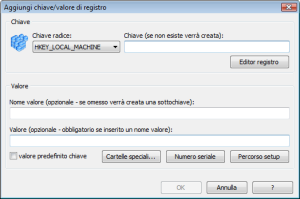![]() CyberInstaller
Studio - 19. Adding
a key or a value in the register
CyberInstaller
Studio - 19. Adding
a key or a value in the register
Clicking on the "Add" step 10 - "keys/values Log" will open a window through which you can specify all the parameters relating to the key or registry value that you want to be created during the installation process distributed software.
![]() Note:
As this step allows you to edit the registry of Windows, you must take
particular care in its completion.
Note:
As this step allows you to edit the registry of Windows, you must take
particular care in its completion.
Through this step, indeed, you can enter values
that, going to overwrite any existing values, could seriously affect
the behavior of Windows, if the corresponding keys have no effect on
the system. We suggest,
therefore, to create keys and values for the sole purpose of preparing
the system with the use of their software. Note that, however, the
registry change (insertion keys, etc..) Should be handled by your
application (eg insertion chieavi first start, etc..) and only rarely
during installation.
The strings that make up a
key, modeled on the syntax for paths of filenames. The
differences are that instead of the drive, there is a fixed root key
that can be 5 types:
HKEY_CURRENT_USER,
HKEY_USERS, HKEY_LOCAL_MACHINE, HKEY_CLASSES_ROOT, HKEY_LOCAL_MACHINE.
![]() CyberInstaller
Studio - 19.1. Using
the window "Add key/value registry"
CyberInstaller
Studio - 19.1. Using
the window "Add key/value registry"
Key root [list] - Example: "HKEY_LOCAL_MACHINE"
Root key name to use for the subkey that you want to create. It's required to choose at least one of the 5 values present. The default is HKEY_LOCAL_MACHINE. The meanings of the possible values are shown in the following table:
| Default root key | Description |
| HKEY_CURRENT_USER | Contains the root of the configuration information about the user currently logged on. This window stores the user's folders, screen colors, and settings in Control Panel. All of this information constitutes the user's profile. |
| HKEY_USERS | Contains the root of all user profiles on your computer. HKEY_CURRENT_USER is a subkey of HKEY_USERS. |
| HKEY_LOCAL_MACHINE | Contains configuration information specific to the computer for all users. |
| HKEY_CLASSES_ROOT | It is a subkey of HKEY_LOCAL_MACHINE\Software. The information stored here ensures the correct program to open when you open a file using Windows Explorer. |
| HKEY_CURRENT_CONFIG | Contains information about the hardware profile used by the local computer at system startup. |
 Key [field] - Example:
"\Gui\Settings"
Key [field] - Example:
"\Gui\Settings"
It's the full name of the subkey
(the key itself is given by the root + the subkey) you want to create.
It's possible include several subkeys
simultaneously. In this case you must
separate them using the "\", just as happens with file paths. CyberInstaller Studio,
in this case, will think to create them all automatically. If you do not insert
the character "\" at the beginning (which separates from the
rest of the key root key (just as happens with the drives and folders
in the path names of files and folders) will be added automatically.
Registry
Editor [button]
Allows you to open the registry editor. This editor lets you edit the Windows registry and therefore must be used with caution, because you can make the system unreliable, compromising performance, or even preclude the start. In this window, through this button, the editor should be used only to copy the name of a key (via its menu item "Edit/Copy key name") in his system, enabling the system to re-create the destination without having to manually type (the names of the keys can be very long and complex). The key name will be just copied and then pasted into the field "Key" by pressing the right mouse button in this area and a subsequent click with left button on "Paste."
Name value [field] [optional] - Example: "SaveOnExit"
Name of the value
that you want to create. It's only mandatory if you
want to create a "value" in the specified key. If you enter |default_value|
the "value" is the default value for the key you created (each key has
a default value).
Value [field] [optional / obligatory] - Example: "true"
Value you want to create. It's mandatory only if you entered a "name value", not if you just added a "key".
Default key [checkbox] [optional] - Default: False
If selected, the
field "Value Name" will be set to "|default_value|" and the "Value"
will be the default value (default) for the key created (each key has a
default value). You need not create a default value for each key
you created (it is required only in special cases).
Special Folders ... [button]
Allows you to automatically insert in the Value field pattern which is a special system folder (eg "| $ AppPath $ |" to identify the destination folder, or "|$WinPath$|" to that of Windows, etc.).. box appears allowing you to choose a pattern system.
Serial Number [button]
Add in the Value box "|%SERIALCODE_VALUE%|" which is the serial code of the application.
Path setup [button]
Add in the Value box "|%SETUP_PATH%|" ie the path from which it was executed installaizone application (launching Setup.exe).
OK [button]
Adds the key or registry value to the current package. Equivalent to pressing <ENTER>.
Cancel [button]
Close the window without taking into account the changes made. Equivalent to pressing <ESC>.
 CyberInstaller
Studio - 19.2. Examples
CyberInstaller
Studio - 19.2. Examples
Example 1:
You want to create the value "true", called "SaveOnExit" in subkey
"Gui\Settings", located in the root-key HKEY_LOCAL_MACHINE:
Root Key = HKEY_LOCAL_MACHINE
Key = "\Gui\Settings"
Value name = "SaveOnExit"
Value = "true"
default key = [No]
Root Key = HKEY_LOCAL_MACHINE
Key = "\MySoftware\Users"
Value name = "|default_value|"
Value = "Anonymous"
default key =
[Yes]
![]() See
also ...
See
also ...
![]() Step
8 - External Applications
Step
8 - External Applications